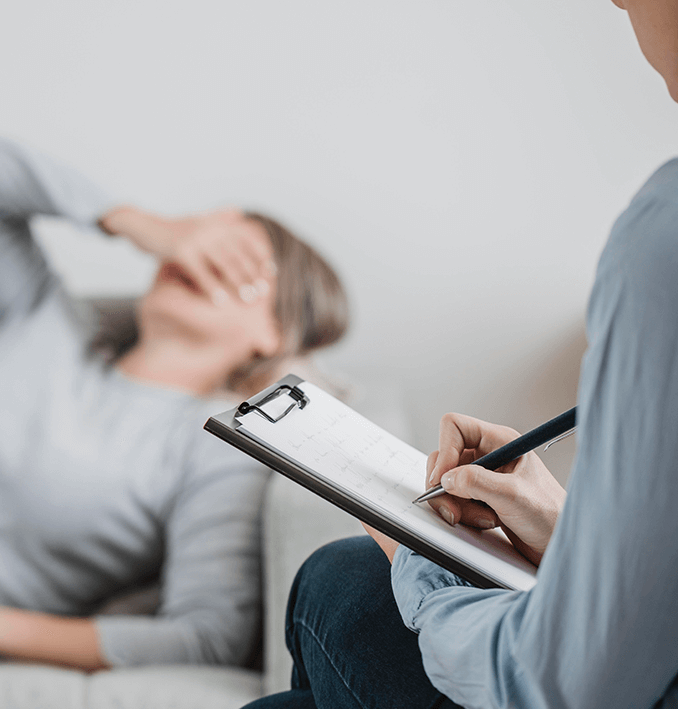Obsessive-compulsive disorder (OCD) is a mental health condition that manifests through obsessive thoughts and compulsive actions. Among U.S. adults, the lifetime occurrence of OCD stands at
This article aims to shed light on the intricate nature of OCD, particularly focusing on obsessive-compulsive symptoms in adults. We will delve into understanding OCD episode symptoms, learn how to recognize the warning signs of OCD and move beyond the stereotypes surrounding this complex condition.
The Nature of Obsessions
OCD-related obsessive thoughts are more than just intense or repetitive worries about regular daily matters. These are persistent, unwanted thoughts, impulses, or images that trigger obsessions, distress, or anxiety. They are intrusive and often irrational, yet they are extremely difficult to ignore or control.
Obsessive thoughts are not simply excessive concerns about real-life problems but are often about things that might seem illogical or nonsensical to others. The individual with OCD usually recognizes these obsessions as being a product of their own mind but feels powerless to stop them. Examples include:
- Obsessive fears of dirt or being contaminated by touching objects others have touched.
- Doubting and having a hard time dealing with uncertainty. People may check if they’ve locked the door or turned off the stove several times.
- Intense stress when objects aren’t orderly, symmetrical, or facing a certain way.
Intrusive Thoughts: Are They Always the OCD Symptom?
Everyone can sometimes feel stuck in a loop of unwelcome intrusive thoughts. Although they are one of the common OCD characteristics, these thoughts are not necessarily associated with the disorder. It’s recommended to see a mental health professional if intrusive thoughts:
- are so persistent that they disrupt your daily life;
- cause significant distress and anxiety;
- are followed by a strong impulse for compulsive behaviors;
- are too difficult to control even though you understand they are irrational.
Note that such thoughts can be a symptom of not OCD but an anxiety disorder or depression. That’s why it’s important to consult a healthcare provider who will conduct a comprehensive assessment and make a diagnosis.
The Nature of Compulsions
Compulsions in OCD are supposed to bring relief from the intense anxiety caused by obsessions. However, this relief is short-term, creating a cycle where compulsions become a ritualistic but not highly effective response. This cycle can be time-consuming and significantly interfere with a person’s daily activities and social interactions. Moreover, compulsions might not feel satisfying but create additional pressure. Some examples include:
- Excessive hand-washing or cleaning.
- Checking doors over and over again to make sure they are locked.
- Counting in certain patterns.
- Ordering and arranging things over a long period.
- Repeating specific routines or words silently.
A comprehensive meta-analysis of brain imaging studies revealed that individuals with OCD exhibit a hyperactive error processing mechanism and challenges in implementing inhibitory control. This finding sheds light on the biological aspects influencing the persistence of compulsive actions.
Related Mental Health Problems
Obsessive-compulsive disorder can be associated with, or exacerbate, various other conditions:
- Depression. The relentless nature of OCD can lead to feelings of hopelessness and depression. The constant battle with intrusive thoughts and compulsive behaviors can be exhausting and demoralizing.
- Eating disorders. There is a notable
link between OCD and eating disorders[2] . The compulsive behaviors and rigid thinking patterns of OCD can similarly manifest in the strict control and rituals around food and eating. - Generalized anxiety disorder. OCD and generalized anxiety disorder (GAD) share common features like excessive worrying. If a person needs both OCD and anxiety disorder treatment, it is more focused on specific obsessions and compulsions.
- Hoarding disorder. Previously considered a part of OCD, hoarding disorder is now recognized as a distinct condition. It involves persistent difficulty discarding possessions, regardless of their actual value, often due to a perceived need to save them.
Is It Possible to Self-diagnose OCD?
Only a healthcare provider can diagnose OCD and offer a treatment regimen. Moreover, obsessive-compulsive symptoms in adults can overlap with other mental health disorders, so it’s important to see a professional to get an accurate diagnosis. However, it’s also beneficial to know the signs indicating the need for professional assessment:
- Persistent unwanted thoughts or images. Experiencing recurring, persistent thoughts, urges, or images that cause distress and are difficult to control.
- Compulsive behaviors. Performing specific actions repeatedly (like washing hands, checking things, or counting) to alleviate the anxiety caused by intrusive thoughts.
- Time-consuming rituals. If obsessions and compulsions consume a significant amount of your time (typically more than one hour a day) and interfere with your daily life, this is a strong indicator of OCD.
- Recognized excessiveness. People with OCD often realize that their obsessions and compulsions are excessive or unreasonable, but they feel powerless to stop them.
OCD is not about being neat, organized, or liking things a certain way. It is a serious condition that can affect your mental health and daily functioning.
Bottom Line: Seeking Help and Embracing Treatment
Understanding and managing obsessive-compulsive disorder hinges on recognizing its impact on your daily life and mental well-being. If persistent, intrusive thoughts and repetitive behaviors significantly disrupt your routine, cause distress, or lead to physical harm, it is a signal to seek professional help. If you want your OCD treated, reaching out for assistance is a brave and necessary step towards recovery.
Mental health professionals at MEDvidi can provide a proper diagnosis and create an individualized OCD treatment plan, potentially involving medication. Acknowledging the need for help and taking action is crucial, as early intervention can lead to more effective management of early OCD signs, enabling a healthier, more balanced life.
FAQ
Is overthinking related to OCD or anxiety?
Overthinking can be associated with any of these conditions or none of them. In the context of OCD, repetitive intrusive thoughts are often related to specific obsessions. To identify the underlying condition, it’s important to see a healthcare provider who can assess your mental health comprehensively.
What are the five main symptoms of OCD?
Common OCD symptoms include persistent and intrusive thoughts (obsessions), repetitive behaviors, time-consuming compulsions, excessive need for order or symmetry, and distress when rituals are interrupted.
Can you have OCD tendencies but not OCD?
Yes, some individuals may exhibit minor OCD symptoms or tendencies, such as occasional obsessive thoughts, without having full-blown OCD.
What are the main traits of OCD?
The main OCD traits in adults involve having recurring, intrusive thoughts (obsessions) and engaging in repetitive behaviors (compulsions), often aimed at reducing anxiety or preventing a feared event.
What are the hidden traits of OCD?
Lesser-known OCD symptoms can include internal rituals, mental compulsions, avoidance behaviors, and subtle checking or counting not obvious to others. If you experience these symptoms, seeking professional help is recommended for diagnosis and appropriate treatment.
What causes OCD?
OCD development is multifactorial, involving a combination of genetic, neurological, behavioral, cognitive, and environmental factors.
What is the severity of OCD symptoms?
The severity of OCD symptoms can range from mild signs of OCD, like minor disruptions in daily life, to extreme symptoms, where they can significantly impair functioning.









